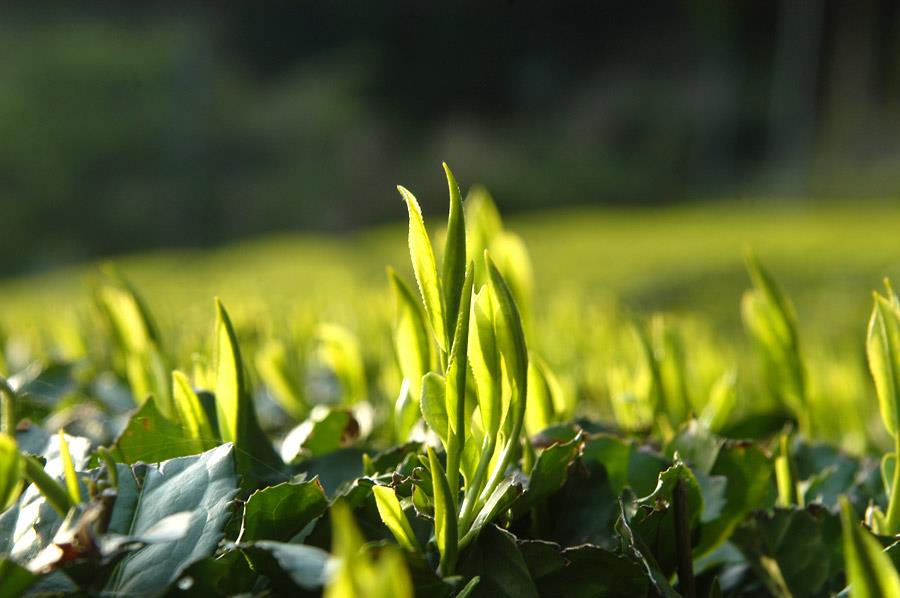山間の谷と広々とした平野が織りなす壮大な景色
何世紀にもわたる伝統と豊かな文化遺産
温かい田舎のコミュニティ
受賞歴のある玉露…
もし上記の記述に共感するなら、八女はまさにあなたにぴったりのお茶の楽園かもしれません!今日は秋分の日。日本有数のお茶の産地である八女について触れるとともに、八女の玉露の魅力をお伝えしたいと思います。
まず、八女市は日本の最南端の島、九州の中心部に位置し、 福岡県で2番目に広い地域(480平方キロメートル)です。八女市は筑後平野の南部に位置し、九州最大の2つの川、筑後川と矢部川に挟まれています。そのため、この地域は肥沃な土壌と天然の水源に恵まれています。降水量が多く、昼夜の寒暖差が大きい八女市は、高品質のお茶を生産するのに最適な条件を備えています。特に八女市の山岳地帯は霧が多く日照時間が少ないため、玉露などの高品質のお茶の生産に適しています。八女市はまた、400年の歴史を持つ手漉き和紙、仏壇や提灯、竹かご、陶器など、何世代にもわたって受け継がれてきた伝統的な民芸品でもよく知られています。この地域には多くの茶農家が暮らし、伝統文化を探求する職人も数多く存在します。しかし残念ながら、私はこの魅力的な地を訪れたことはありません。
八女玉露がゴールドスタンダードである理由
八女市には日本の伝統、文化遺産、自然に触れる機会がたくさんあるのは事実ですが、この投稿はYunomi が日本の主要な茶生産地を特定するという探求を対象としているため、特に八女のお茶に焦点を当てます。特に、八女の玉露です。始める前に、玉露と煎茶の違いを理解しておく必要があります。玉露は、日陰で栽培される高級な日本緑茶です (ただし、これは煎茶より優れているという意味ではありません。並べて比較するお茶ではありません)。まろやかで豊かなうま味があります。煎茶は一般的に直射日光の下で栽培されますが、玉露は遮光プロセスによって栽培されます。一般的に、遮光期間は約 20 日間と言われていますが、この期間は農家や地域によって異なります。遮光により、葉のアミノ酸バランスが L-テアニンの増加に変わり、なめらかな旨味が生まれます。
玉露は、1835年、江戸時代の京都で茶商と農家の協力により誕生しました。この時代背景を少し説明しておくと分かりやすいでしょう。玉露は、日本における碾茶や抹茶の主な消費者であった武士(支配階級)が経済的に非常に困窮していた時代に発明されました。そのため、茶商は目新しいものや販路を開拓する必要に迫られました。玉露の起源は、山本山茶商の6代目である山本嘉兵衛という茶商が宇治を訪れた際に、木下の茶農家のお茶が当時のほとんどの煎茶よりも優れていることに気づき、このタイプのお茶を再現したいと思ったことに遡ります。しかし、山本氏はどんなに努力しても宇治で飲んだお茶を再現することができず、諦めていました。その後、宇治出身の江口重十郎という人物がその秘密(茶葉を覆うこと)を解明し、玉露の栽培と加工方法を改良しました。実際、木下茶農家を含む多くの宇治の農家は、霜から茶葉を守るために藁で茶葉を覆っていました。玉露は煎茶道の達人である小川嘉進によって発見されたという説や、宇治の碾茶生産者である松林正平によって発見されたという説もあります。結局のところ、玉露を発明したのはおそらく一人ではなく、この時代の茶商と農家の共同の努力によって発展してきたという歴史的事実こそが重要なのです。
では、なぜ八女産の玉露が最高級とされているのでしょうか?京都のすぐ南に位置する本州、宇治(特に宇治田原と京鍋地区)は、玉露の産地として最高級とされることが多いです。茶の栽培地として、そして玉露の起源が宇治であることからもわかるように、宇治は玉露栽培に最適な条件を備えているからです。八女産は日本茶市場の玉露の50%以上を生産していますが、生産量が多いからといって必ずしも最高級の玉露であるとは限りません。八女産の玉露の優位性は、近年の茶品評会での記録にも表れています。八女玉露は、2001年から2012年まで12年連続で全国茶品評会(日本茶の最高峰のイベント)で最優秀賞を受賞していましたが、 2013年に宇治の農家がその記録を打ち破りました。八女の茶農家は、8月に鹿児島で開催されたばかりの最近の品評会を含め、頻繁に1位を獲得し続けています(それ以降の1位は、八女と宇治の茶農家の争いのようです)。今年は、玉露品評会で1位から36位までを八女の茶農家が独占しました(他の都道府県の農家も参加していました。今年は119のエントリーがあり、埼玉県、静岡県、愛知県、三重県、京都府、奈良県、鹿児島県、福岡県から茶農家がいました)。今年の玉露品評会で準優勝したのは、 Yunomiとゆかりのある栗原茶園の栗原章弘さんです。章弘さんは、約15年間玉露を栽培しており、しかし、玉露栽培の技術については、まだ学ぶべきことがたくさんあると彼は言います。常に挑戦し続けていますが、それが彼を情熱的にさせているのです。直近のコンテストで199/200点(優勝者は満点)を獲得したパフォーマンスを振り返り、彼はこう語りました。
「日本一にまた一歩近づきました。2位は2回目なので悔しさは倍増です。でも、全力を尽くしたので後悔はありません。ご協力いただいた皆様、ありがとうございました!」
玉露栽培の技術
最高の評価を得るには、味、香り、茶葉の形から微妙な色まで、お茶のあらゆる側面において完璧(もしくはそれに非常に近いもの)であることが求められます。あらゆる技術と同様に、玉露の栽培にも困難が伴います。長年の経験と試行錯誤、自分の洞察力を傾聴する能力、そして時には少しの幸運さえも必要とする、骨の折れる作業です。決して容易なことではないことから、日本全国で玉露農家の数は減少傾向にあり、茶農家の総数も同様に減少しています。福岡県では、2000年には2,217戸の茶農家がいましたが、2015年には962戸に減少しました(農林業センサス)。
日本の茶畑の風景に馴染みのある方なら、茶畑は山間部や斜面にあることをご存知でしょう。玉露は、日光の少ない谷間など、そのような場所で栽培されることが多いです。本物の玉露を育てるには、茶樹を剪定せず、自然に生育させるのが一般的です。このタイプの玉露は、年に一度だけ手摘みで収穫されます。最も重要なのは、高品質の玉露には繊細な遮光技術が不可欠だということです。実際、玉露用の茶葉を日光から守るため、新芽が1~1.5個出ると、茶畑全体が網で覆われます。前述のように、この遮光によって、緑茶に独特の風味を与えるアミノ酸であるテアニンの含有量が増加します。遮光は通常、天井の棚の下で行われます(つまり、遮光構造物が茶樹を直接覆うことはありません)。近年では、伝統的な藁による遮光方法に代わり、合成繊維が玉露生産茶園全体で使用されています。八女玉露が際立つもう一つの理由は、多くの八女茶農家が伝統的な製法、つまり藁を編んだ網で茶葉を覆う製法を守り続けていることです(合成繊維は網の設置・撤去を容易にしますが、茶葉の温度を上昇させてしまいます)。また、網を掛ける工程は茶葉の色にも影響を与え、玉露農家は茶葉の色に非常にこだわります。網の掛け具合によって茶葉の色は大きく変化しますが、内側が輝くエメラルドグリーンが理想的とされています。実際、茶葉の品評会には色に関する部門が設けられています。

手作業で作られた竹や藁を使った伝統的な遮光。その自然な遮光から滴り落ちる水分が栗原茶園のお茶の風味を引き立てます。
人、コミュニティ、つながり
八女の茶農家が長年にわたり、最高品質の玉露で受けてきた評価以上に大切なことがあるかもしれません。八女の人々に尋ねれば、彼らの玉露がナンバーワンである理由は、八女の人々と地域社会のおかげだと答えてくれるかもしれません。多くの八女茶農家は、地域社会にも貢献しています。彼らは勤勉で才能があり、協調性も豊かです。お茶への情熱を持ち、日本の伝統と文化を守ることに心を砕いています。また、八女茶文化センター、茶祭り、お茶体験などを通して、お茶文化を他の人々と喜んで共有しています。八女が「お茶の国」と呼ばれるのも当然と言えるでしょう。
YunomiからYamechasを探る
- 栗原茶園:今年の玉露部門で準グランプリ、大臣賞を受賞した栗原昭夫氏の茶園。栗原茶園は玉露の栽培と加工のスペシャリストとして高い評価を得ています。1922年に茶問屋として創業しましたが、1942年に初代当主が八女茶の高品質で定評のある八女地方に事業を移し、自ら茶栽培を始めました。息子の栗原吉平氏は現在、八女市議会議員として活躍し、息子の雄二氏と昭夫氏が茶業を継承しています。栗原茶園の品揃えはどれも一見の価値ありです!
- 久万茶園:八女市にある、受賞歴のある茶園です。この茶園は、茶農家の叔父や従兄弟を代表し、日本茶インストラクターとして活躍する中谷一美さんが経営しています。久万茶園は長年にわたり数々の賞を受賞していますが、近年の若手スターとして、従兄弟の久万正弘さんが2017年の全国茶品評会玉露部門で最高賞(大臣賞)を受賞しました。その年、彼の玉露は200点満点中200点を獲得した唯一の玉露でした!残念ながら、今年の玉露は完売してしまいました。ちなみに、久万さんと栗原茶園の栗原昭夫さんは高校の同級生で、よく競い合っているそうです。
- 千代乃園:福岡県八女市矢部村の標高600メートルの常緑山々に囲まれたこの小さな茶園は、3代目となる農家の原島正司・絵里夫妻によって運営されています。日本の最高峰の農業賞である農業大臣賞を3度受賞している原島正司氏は、日本を代表するトップクラスの農家の一人です。南部に位置しながらも、標高が高いため、千代乃園の茶畑は冬は雪に覆われます。涼しい気候によって害虫が減り、無農薬で茶を栽培することができます。原島さんの茶園は高級な山岳地帯の煎茶と玉露を専門としていますが、私は最近、同園の上質な玄米茶を楽しみました。私は昔から玄米茶の焙煎したような香りが好きでしたが、この玄米茶は矢部村(八女地方)の山の香りが加わって、本当に素晴らしく、心が落ち着きます…うーん!
 千代乃園:茶農家原島正志さん・絵里さん夫妻。
千代乃園:茶農家原島正志さん・絵里さん夫妻。
八女市の急須キャラクター「八女茶丸」
最後に、このお茶の産地、八女市がお茶に真剣に取り組んでいることの証として、公式マスコットキャラクターがいることが挙げられます。2007年、福岡県茶業振興協議会は、茶葉の色をしたかわいい急須のキャラクター「やめちゃまる」をマスコットキャラクターとして採用することを決定しました。また、八女茶のスローガンとして「福岡の八女茶はいい色 いい味 いい香り」を掲げています。八女市を訪れる機会があれば、かわいい八女茶まるのぬいぐるみに出会えるかもしれませんよ!
注目の画像クレジット: 千代乃園。福岡県八女市。


